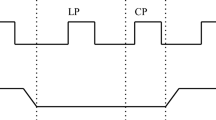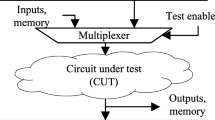Abstract
In nanometric technologies, testing of delay faults in the integrated circuits is becoming mandatory during manufacturing test. Delay fault testing involves two test vectors. Scan based designs is used for delay fault testing with architectural limitations of traditional scan limits the two pattern delay tests that can be applied to a design which results in degraded delay test coverage. Transition delay fault (TDF) coverage improves appreciably by the use of enhanced scan design as it solves the problem by supporting arbitrary delay test vector pairs at the cost of high area overhead. It also needs fast hold signal which is analogous to scan enable signal as in case of LOS testing. Delay testable enhanced scan flip–flop (DTESFF) has been proposed as a low cost DFT technique to achieve high TDF coverage using enhanced scan design without the need of fast hold signal. In this work, a partial DTESFF scheme augments few scan flip–flops with the DTESFF design by choosing scan flip–flops carefully. It attains most of the TDF coverage advantages of a full DTESFF design with reduced area overhead. Significant improvement in TDF coverage for partial enhance scan using DTESFF has been seen on ISCAS’ 89 benchmark circuits.








Similar content being viewed by others
References
Abraham J, Goel U, Kumar A (2006) Multi-cycle sensitizable transition delay faults. In: Proceedings of VLSI test symposium, pp 306–311
Bushnell ML, Agrawal VD (2000) Essentials of electronic testing for digital, memory and mixed-signal VLSI circuits. Springer, New York
Cheng K-T et al (1991) A partial enhanced scan approach to robust delay-fault test generation for sequential circuits. In: Proceedings of international test conference, pp 403–410
Chao H, Singh AD, Singh V (2011) Efficient partial enhanced scan for high coverage delay testing. In: Proceeding of IEEE 43rd southeastern symposium on system theory (SSST), pp 243–248
Deepak KG, Reyna R, Singh V, Singh AD (2009) Leveraging partially enhanced scan for improved observability in delay fault testing. In: Asian test symposium ATS 2009, pp 237–240
Devtaprasanna N, Gunda A, Krishnamurthy P, Reddy SM, Pomeranz I (2005) Methods for improving transition delay fault coverage using broadside tests. In: Proceedings of international test conference, pp 256–265
EEDesign Article (2002) Delay-fault testing mandatory, author claims, Dec. http://www.eedesign.com/story/OEG20021204S0029. Accessed Jan 2011
EETimes Article (2003) Scan-based transition-fault test can do job, Oct. http://www.eetimes.com/story/OEG20031024S0028. Accessed Jan 2011
Hawkins C, Keshavarzi A, Segura J (2003) A view from the bottom: Nanometer technology AC parametric failures—why, where, and how to detect. In: Proceedings of international symposium on defect fault tole, pp 267–276
Hurst JP, Kanopoulos N (1995) Flip–flop sharing in standard scan path to enhance delay fault testing of sequential circuits. In: Proceedings Asian test symposium, pp 346–352
Kumar R, Bollapalli KC, Garg R, Soni T, Khatri SP (2009) A robust pulsed flip–flop and its use in enhanced scan design, IEEE international conference on computer design (ICCD), pp 97–102
Lin CJ, Reddy SM (1987) On delay fault testing in logic circuits. IEEE Trans Comput Aided Des Integr Circuits Syst 6(5):694–703
Mak T, Krstic A, Cheng KT, Wang LC (2004) New challenges in delay testing of nanometer, multigigahertz designs. IEEE Des Test Comput 21(3):241–247
Namba K, Ikeda T, Ito H (2010) Construction of SEU tolerant flip–flops allowing enhanced scan delay fault testing. IEEE Trans Very Large Scale Integr VLSI Syst 18(9):1265–1276
Nassif S (2000) Delay variability: sources, impacts and trends. In: Proceedings of international solid state circuits conference, pp 368–369
Patil S, Savir J (1992) Skewed-load transition test: part II, coverage. In: Proceedings of international test conference, p 714
Pei S, Li H, Li X (2011) Flip–flop selection for partial enhanced scan to reduce transition test data volume. IEEE Trans Very Large Scale Integr VLSI Syst PP(99):1–13
Savir J (1992) Skewed-load transition test: part I, calculus. In: Proceedings of international test conference, p 705
Savir J, Patil S (1994) On broad-side delay test. Very Large Scale Integration (VLSI) Systems 2, 368
Saxena J, Butler KM, Gatt J, Raghuraman R, Kumar SP, Basu S, Campbell DJ, Berech J (2002) Scan-based transition fault testing—implementation and low cost test challenges. In: Proceedings of international test conference, pp 1120–1129
Seongmoon W, Xiao L, Chakradhar ST (2004) Hybrid delay scan: a low hardware overhead scan-based delay test technique for high fault coverage and compact test sets. In: Proceedings of design, automation and test in Europe, pp 1296–1301
Suhag AK, Shrivastava V (2011) Delay testable enhanced scan flip–flop: DFT for high fault coverage. In: Proceedings of international symposium on electronic system design (ISED), pp 129–133
Suhag AK, Shrivastava V (2012) Performance evaluation of delay testable enhanced scan flip–flop. Int J Syst Assur Eng Manag 3(3):169–174
TekuMalla RC et al (1997) Delay testing with clock control: an alternative to enhanced scan. In: Proceedings of international test conference, pp 454–462
Waicukauski JA, Lindbloom E, Rosen B, Iyengar V (1987) Transition fault simulation. IEEE Des Test Comput 4:32–38
Wang S, Wei W (2008) Low overhead partial enhanced scan technique for compact and high fault coverage transition delay test patterns. In: Proceedings of European test symposium, pp 125–130
Wang S, Liu X, Chakradhar ST (2004) Hybrid delay scan: a low hardware overhead scan-based delay test technique for high fault coverage and compact test sets. In: Proceedings of design, automation and test in Europe, pp 1296–1301
Xu G, Singh AD (2006) Low cost launch-on-shift delay test with slow scan enable. In: Proceedings of European test symposium, pp 9–14
Xu G, Singh AD (2007) Achieving high transition delay fault coverage with partial DTSFF Scan Chains. In: Proceedings of international test conference, pp 1–9
Zhang Z, Reddy SM, Pomeranz I, Lin X, Rajski J (2006) Scan tests with multiple fault activation cycles for delay faults. In: Proceedings of VLSI test symposium, pp 343–348
Author information
Authors and Affiliations
Corresponding author
Rights and permissions
About this article
Cite this article
Suhag, A.K., Shrivastava, V. & Singh, N. Flip–flop selection for partial enhance scan chain using DTESFF for high transition delay fault coverage. Int J Syst Assur Eng Manag 4, 303–311 (2013). https://doi.org/10.1007/s13198-013-0170-9
Received:
Revised:
Published:
Issue Date:
DOI: https://doi.org/10.1007/s13198-013-0170-9




